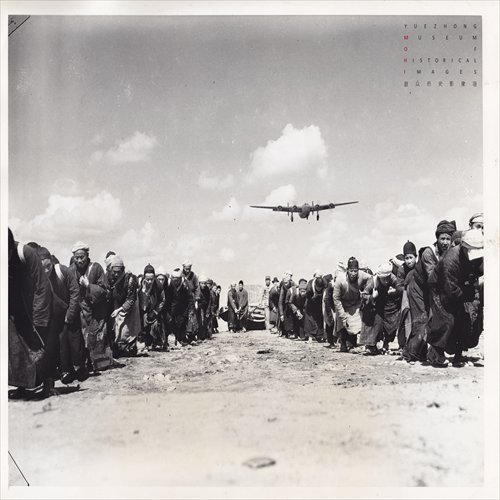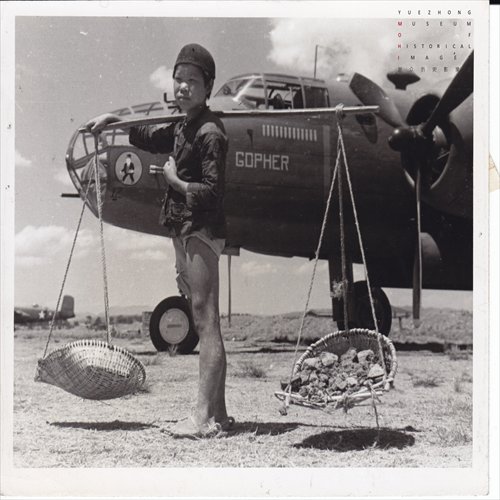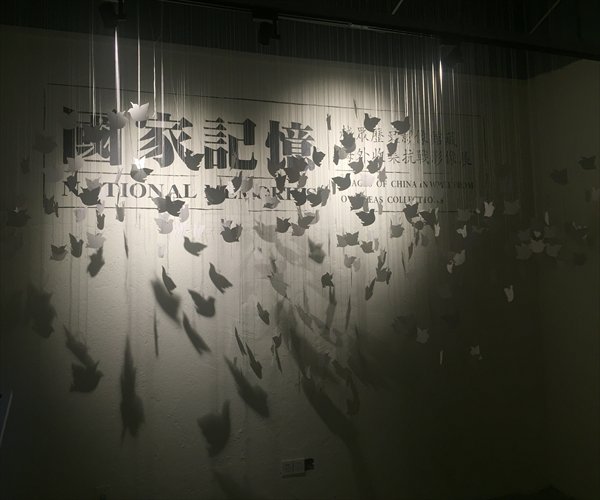HOME >> ARTS
‘National Memory’
By Li Jingjing Source:Global Times Published: 2015-8-16 20:33:01
Photo exhibition provides window into the lives of those who fought during WWII

Workers build a landing strip on March 31, 1944

A boy poses for a picture next to a US B-25 bomber plane.Photos: Courtesy of Yuezhong Museum of Historical Images
"That really reminds of what we did during the war," said 90-year-old Wong Kwong-hon as he looked at the old images of Chinese military messengers training to use communication equipment and writing down messages.
Wong was a member of the China Expeditionary Force and joined the Yunnan-Myanmar War against the Japanese (1942-1945) when he was only 17. Viewing the images and footage from WWII displayed at the Yuezhong Museum of Historical Images (MoHI) in Shenzhen took him back to this unforgettable period of history.
Eighty-nine-year-old Wong Shu-hoi used to a platoon leader in the Sixth Army during the war couldn't have been more excited to share his memories of how he fought on the battlefield and captured two Japanese soldiers.
"I hope young people can understand what the war was like," Wong Kwong-hon told the Global Times.
They are among six Chinese veterans that came to see the exhibition displaying the history in which they all took part.
To try and present this part of history from multiple angles, the exhibition National Memory - Images of China in WWII from Overseas Collections has gathered a substantial amount of photos from organizations like the National Archives and Record Administration (NARA) in the US and personal photos from overseas Chinese who were involved in the war, as well as dozens of documentaries and movies.
"The larger history was made up of countless individual memories. Paying attention to small details is a way to restore history. That's why we have collected smaller items. We want to help people to have a more comprehensive understanding of history," said Huang Liping, MoHI's executive director.
Individual contributions
Over 200 photos from NARA are on display, most of them taken by the 163th Photo Company of the US Army Signal Corps while stationed in the China Burma India Theater.
While most of these photos have been shown around China since 2011, the museum has recently added more images for the current exhibition. Instead of displaying things in chronological order, MoHI has categorized items into three sections based on the three main means by which US troops contributed to the Chinese war effort: military training, the Flying Tigers and joint combat against Japanese forces.
Another part of the exhibition delves into the stories of individuals. For instance, photos and stories about American Chinese John C. Young (1912-1987) and his family's involvement in WWII are on display.
Originally working as an engineer for Standard Oil in Los Angeles, Young had also joined the Army Reserve Officer's Training Corps. A few months after the attack on Pearl Harbor, Young was commissioned as a First Lieutenant and sent overseas. His contributions included organizing supply air-drops to troops along the Burma Road and helping equip the Chinese army with new American weapons.
Individuals like him are deeply connected to the history of the two countries.
"My father would become a very successful businessmen and respected community leader, but deep inside, he was proudest of what he did during the war. The China-Burma-India years were forever imbedded in his soul, what he experienced in the field was part of world history," wrote Young's daughter Connie Yu, who had donated her father's belongings to the museum, in a letter for the exhibition.

The main exhibition hall of the Yuezhong Museum of Historical Images Photo: Li Jingjing/GT
Multi-media history
In addition to photos, the most creative part of the exhibition is the huge 3D map that follows the steps of scholar Ge Shuya as he explores the past battlefields where the China Expeditionary Force fought in China's Yunan Province, Myanmar and India.
Visiting Chinese veterans and veteran organizations in China, the US and Japan, Ge managed to collect a large amount of information on the war. To get a better understanding of what he had collected, Ge used military maps, a compass, recorder and camera to explore the areas outlined in his research.
Films from that era allow viewers to see the news, documentaries and publicity films that were made about China before 1945, revealing a peaceful and beautiful China before the war and the struggles of Chinese and US soldiers during the war.
Another highlight, for the first time ever, the Shanghai Audio-Visual Archives has released films made in Guangdong Province during the war, including recordings of the Japanese military's bombing of the Haizhu Bridge and a student rally to donate goods to wounded soldiers and refugees.
"We are not trying to expose and criticize whose fault the war was, or incite hatred toward one nation or draw any nation to our side… Only by respecting life can we reduce frictions among people. During times of peace, we need to reflect on humanity beyond the limits of nations so we may prevent this type of tragedy from happening again," Huang said.
Posted in: Photography